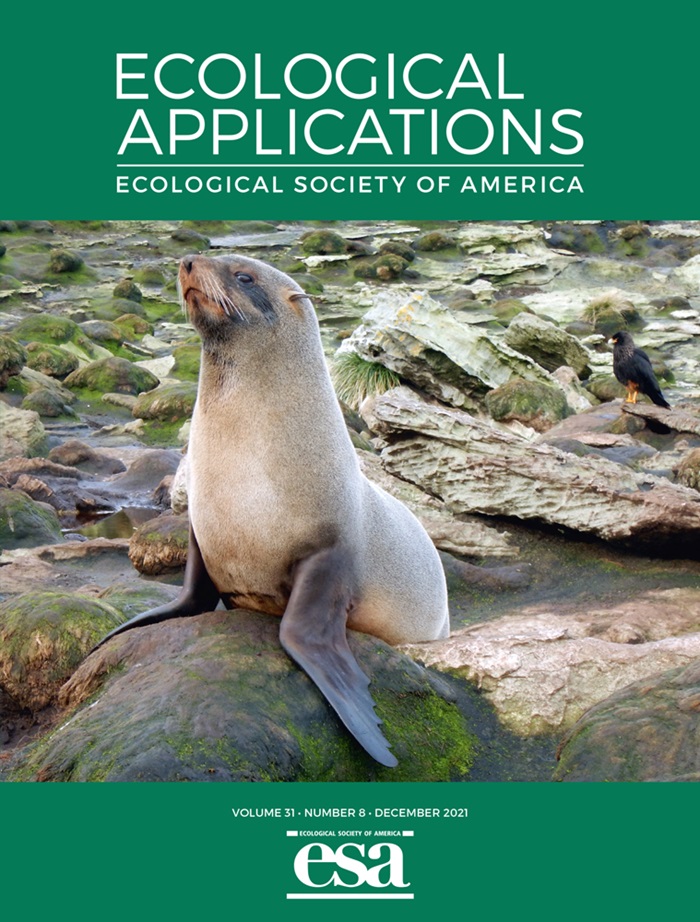非本地猎物可用性和过度补偿密度依赖驱动本地鱼类捕食者的种群动态
IF 4.3
2区 环境科学与生态学
Q1 ECOLOGY
引用次数: 0
摘要
了解调节种群动态的因素对于保护濒危物种至关重要。牛鳟(Salvelinus confluentus)是一种食鱼鲑鱼,也是北美最受威胁的冷水物种之一,由于栖息地丧失、过度捕捞、物种入侵和气候变化,其数量显著减少。虽然恢复工作主要针对这些威胁,但在多种压力源下,猎物可得性在影响鳟鱼种群动态中的作用仍然知之甚少。利用基于阶段的综合种群模型,我们量化了非本地猎物可得性(kokanee; Oncorhynchus nerka)、垂钓压力、气候变化和密度依赖过程对库坎努萨湖(美国和加拿大的一个跨界水库和河流系统)公牛鳟鱼种群动态的影响,时间跨度为40年(1980-2023年)。我们的研究结果表明,鳟鱼种群受密度依赖过程的调节,包括在亚成鱼招募时的过度补偿和高密度下成鱼存活率的降低。kokanee生物量的增加和限制捕捞显著提高了鳟鱼的存活率和丰度,而水分供应的减少对亚成鱼产量的负面影响有限。模型模拟表明,随着可卡尼生物量的增加,可可持续捕捞的鳟鱼数量也会增加。事实上,适度的年捕鱼量(300只)是可以维持的,特别是在中等到高的kokanee生物量条件下。这些结果强调了猎物可得性(包括非本地物种)在支持鳟鱼种群中的重要性。对牛鳟等濒危顶端鱼类捕食者的有效管理需要解决环境威胁、猎物动态和整个生命阶段的密度依赖机制之间复杂的相互作用。本文章由计算机程序翻译,如有差异,请以英文原文为准。
Non‐native prey availability and over‐compensatory density dependence drive population dynamics of a native fish predator
Understanding the factors that regulate population dynamics is crucial for conserving imperiled species. Bull trout (Salvelinus confluentus ), a piscivorous salmonid and one of North America's most threatened cold‐water species, has declined significantly due to habitat loss, overfishing, invasive species, and climate change. While recovery efforts have primarily targeted these threats, the role of prey availability in influencing bull trout population dynamics under multiple stressors remains poorly understood. Using a stage‐based integrated population model, we quantified the effects of non‐native prey availability (kokanee; Oncorhynchus nerka ), angling pressure, climatic variation, and density‐dependent processes on bull trout population dynamics in Lake Koocanusa, a transboundary reservoir and river system (United States and Canada), over a 40‐year period (1980–2023). Our results show that bull trout populations are regulated by density‐dependent processes, including over‐compensation in sub‐adult recruitment and reduced adult survival at high densities. Increased kokanee biomass and restricted harvest significantly enhanced bull trout survival and abundance, whereas reduced water availability had a limited negative effect on sub‐adult production. Model simulations indicate that as kokanee biomass availability increases, the number of bull trout that can be sustainably harvested also increases. In fact, a modest annual fishery (300 individuals) can be sustained, especially under moderate to high kokanee biomass conditions. These results underscore the importance of prey availability, including non‐native species, in supporting bull trout populations. Effective management of threatened apex fish predators like bull trout requires addressing the complex interplay between environmental threats, prey dynamics, and density‐dependent mechanisms across all life stages.
求助全文
通过发布文献求助,成功后即可免费获取论文全文。
去求助
来源期刊

Ecological Applications
环境科学-环境科学
CiteScore
9.50
自引率
2.00%
发文量
268
审稿时长
6 months
期刊介绍:
The pages of Ecological Applications are open to research and discussion papers that integrate ecological science and concepts with their application and implications. Of special interest are papers that develop the basic scientific principles on which environmental decision-making should rest, and those that discuss the application of ecological concepts to environmental problem solving, policy, and management. Papers that deal explicitly with policy matters are welcome. Interdisciplinary approaches are encouraged, as are short communications on emerging environmental challenges.
 求助内容:
求助内容: 应助结果提醒方式:
应助结果提醒方式:


